You can safely use essential oils for pest control around your pets by choosing cedar, lemongrass, or lavender oils with proper dilution—one drop per 200ml of water for diffusers or 1-2 drops per ounce of carrier oil for topical applications. Always avoid toxic oils like tea tree, peppermint, and citrus varieties that can harm cats and dogs. Monitor your pets closely for any adverse reactions and consult your veterinarian before starting any essential oil regimen to discover thorough safety strategies.
Understanding Essential Oil Safety for Cats and Dogs
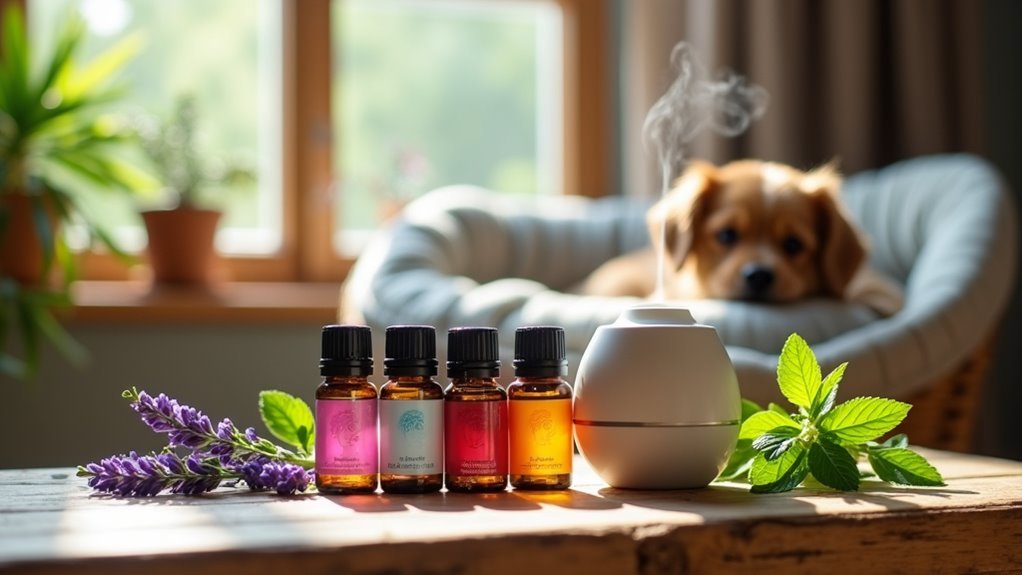
While essential oils offer a natural approach to pest control, you’ll need to exercise extreme caution when using them around your furry companions.
Cats are particularly vulnerable due to their lack of a vital liver enzyme that processes toxins, making many oils potentially dangerous to their health and safety. Certain oils like cedarwood, lemongrass, and lavender are generally safe for use around pets when used in diluted forms and proper ventilation.
Cats lack essential liver enzymes to process toxins, making certain essential oils dangerous despite some being safe when properly diluted.
Never apply oils directly to your pets. Instead, use diluted sprays or diffusers in well-ventilated spaces.
Watch for respiratory irritation, especially in cats when used in concentrated amounts. Always prioritize consultation with a veterinarian before introducing essential oils to guarantee your pets’ wellbeing.
Cedar Oil: The Safest Natural Pest Repellent for Pet Owners
When you’re searching for a natural pest control solution that won’t harm your furry companions, cedar oil stands out as your safest bet.
You’ll find that this essential oil effectively repels mosquitoes, fleas, and ticks while remaining considerably less toxic to cats and dogs than alternatives like tea tree or citrus oils.
Cedar Oil Safety Benefits
As pet owners search for effective pest control solutions that won’t harm their furry companions, cedar oil emerges as the safest natural repellent available.
Unlike many essential oils that can cause health issues in cats, cedar oil is safe for use around your pets when properly diluted. You’ll find that cedar oil effectively targets fleas, ticks, and mosquitoes without exposing your animals to toxic synthetic chemicals.
The active compound cedrol doesn’t just repel pests—it actually disrupts their life cycles, preventing reproduction near your pets.
You can confidently use cedar oil in sprays and diffusers throughout your home. Its biodegradable, cruelty-free nature aligns with responsible pet ownership while delivering the pest control results you need.
Effective Application Methods
Since cedar oil’s safety profile makes it ideal for pet households, you’ll want to master the proper application techniques to maximize its effectiveness.
These essential oils require careful handling to remain safe for pets while delivering powerful pest repellent benefits.
Follow these proven application methods for cedar oil:
- Misting spray technique – Dilute a few drops in water and spray in well-ventilated areas where pests gather.
- Diffuser method – Use an essential oil diffuser in rooms with adequate airflow, keeping pets away during initial application.
- Carrier oil mixture – Combine cedar oil with a neutral carrier oil for targeted outdoor applications.
Always dilute cedar oil properly before use.
Monitor your pets’ reactions closely after introducing any new pest repellent into their environment, as individual sensitivities can vary greatly.
Lemongrass and Lavender: Gentle Options for Flea and Tick Control
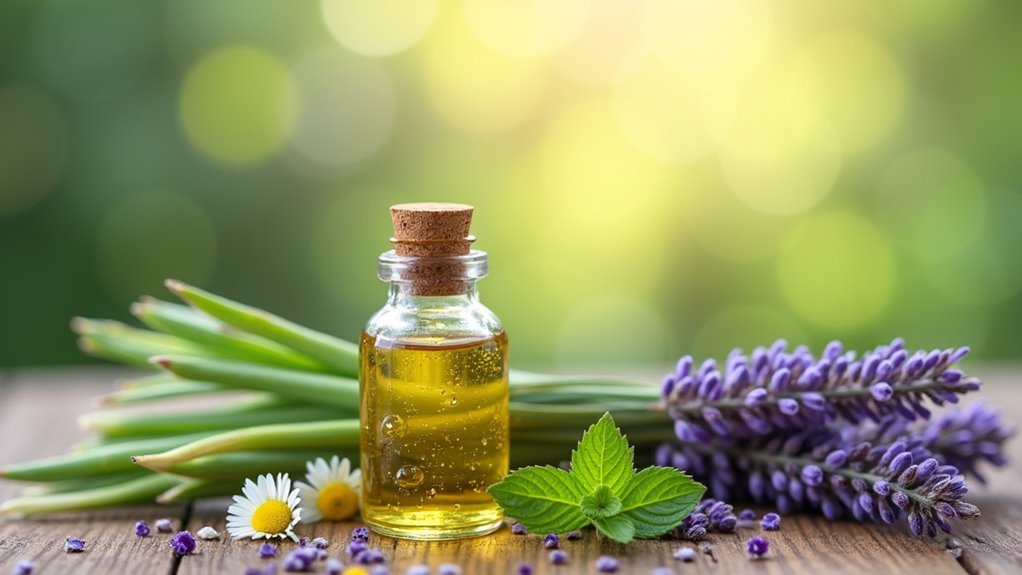
While chemical flea and tick treatments can be harsh on your furry friends, lemongrass and lavender oils offer a gentle yet effective alternative that won’t compromise your pet’s health. These essential oils naturally repel fleas and ticks while maintaining safety for pets when properly diluted.
| Essential Oil | Active Compound | Primary Benefit |
|---|---|---|
| Lemongrass Oil | Citronella | Repels fleas and ticks effectively |
| Lavender Oil | Linalool | Pleasant scent with pest deterrent properties |
Both oils provide eco-friendly pest control solutions that protect your pets from harmful chemicals. You’ll need to guarantee proper dilution and monitor your pets for adverse reactions. Regular application creates a safe environment while effectively managing pest problems naturally.
Toxic Essential Oils to Avoid Around Pets
While some essential oils can help control pests, you must know which ones pose serious health risks to your pets.
Tea tree, peppermint, and citrus oils are particularly dangerous for cats since they can’t metabolize certain compounds effectively, leading to toxicity.
You’ll need to watch for warning signs like respiratory distress, skin irritation, or gastrointestinal problems if your pet has been exposed to these harmful oils.
Highly Toxic Oils
Although vital oils can effectively repel pests, certain varieties pose serious health risks to your pets and should never be used in homes with cats or dogs.
Cats are especially vulnerable because they lack an essential liver enzyme needed to process these compounds safely.
The most dangerous highly toxic oils include:
- Tea tree oil – Causes severe neurological symptoms and liver damage
- Peppermint oil – Triggers respiratory distress and digestive issues
- Citrus oils – Lead to vomiting, diarrhea, and skin irritation
Even diluted forms of these essential oils can cause adverse reactions in pets.
Direct application is particularly dangerous since cats groom themselves constantly, increasing ingestion risks.
Before using any oils for pest control, consult your veterinarian to guarantee your pets’ health remains safe.
Warning Signs Observed
Recognizing the early warning signs of essential oil toxicity can save your pet’s life. Watch for respiratory distress including coughing, wheezing, or difficulty breathing when your cat’s exposed to essential oils.
You’ll notice behavioral changes like lethargy, drooling, vomiting, or loss of coordination. These toxic reactions occur because cats lack the liver enzyme needed to process many oils safely.
Pay attention to skin irritation if oils contact your pet’s fur or paws. Since cats groom themselves constantly, they’ll likely ingest anything on their coat, making toxicity worse.
Tremors, seizures, or collapse require immediate emergency care.
Don’t wait if you observe any symptoms – contact your veterinarian immediately. Quick action guarantees your pet’s safety and prevents serious complications from essential oil poisoning.
Proper Dilution Methods for Pet-Safe Application
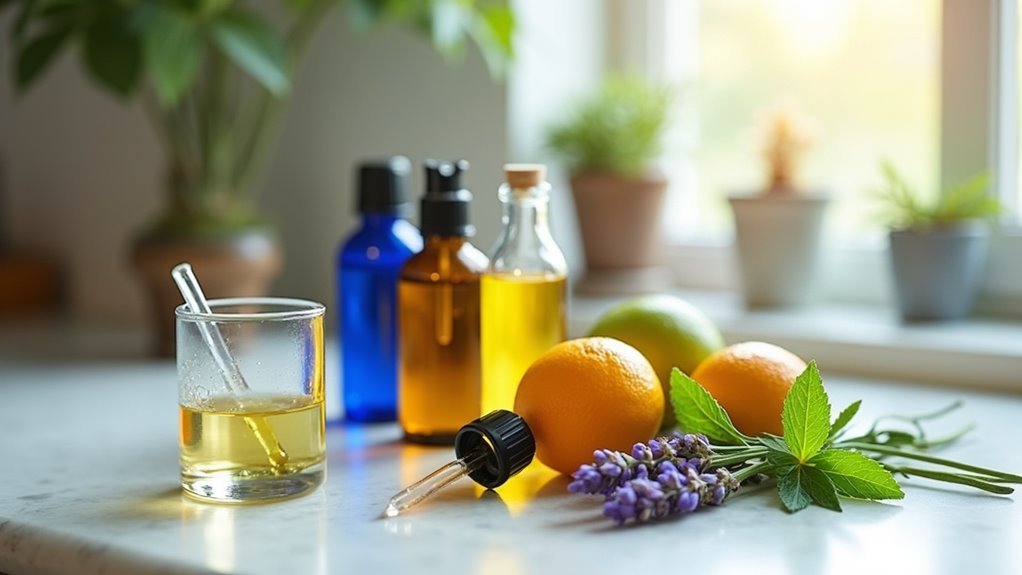
When you’re preparing essential oil solutions for pest control around pets, getting the dilution right makes the difference between effective treatment and potential toxicity.
Proper dilution guarantees essential oils remain safe while delivering effective pest control around your furry companions.
Here are three essential dilution methods for pet safety:
- Topical applications: Mix 1-2 drops of essential oil per ounce of carrier oil for gentle surface treatments.
- Spray solutions: Combine 4-20 drops with 4 ounces of distilled water, shaking well before each use.
- Diffuser blends: Start with just 1 drop in 200ml of water, monitoring your pet’s reactions closely.
Remember that undiluted oils are toxic to pets, especially cats who can’t metabolize certain compounds.
Always prioritize veterinarian consultation before introducing new oils into your pet’s environment.
Diffusion Techniques That Protect Your Furry Friends
Beyond mixing the right concentrations, how you diffuse these solutions around your home directly impacts your pet’s safety and comfort.
Always operate essential oils diffusers in well-ventilated spaces to prevent respiratory irritation, particularly in cats who’re extremely sensitive to strong scents. Start with short diffusion sessions—just a few minutes initially—to gauge your pets’ reactions before extending duration.
Cats are extremely sensitive to strong scents, so always start with short diffusion sessions in well-ventilated areas.
Proper dilution remains vital even during diffusion; one drop of oil per 200ml of water reduces toxicity risks considerably.
Position diffusers where your pets can’t access them, preventing accidental spills or ingestion of concentrated oils. Watch your furry friends closely during and after diffusion sessions.
Any signs of discomfort, unusual behavior, or breathing difficulties require immediate cessation. Your pets’ safety should always take priority over pest control effectiveness.
Creating Homemade Pet-Safe Pest Sprays
Simplicity makes homemade pest sprays an attractive solution for pet owners seeking chemical-free alternatives. You can create effective pest control solutions using essential oils that are safe for pets when properly diluted.
Mix 4-20 drops of cedarwood or lemongrass oil into 4 ounces of distilled water for ideal results.
Follow these essential steps:
- Test first – Apply the spray in small areas and monitor your pets for adverse reactions.
- Allow settling time – Keep pets away from treated areas until the spray has dried completely.
- Adjust concentration – Modify essential oil amounts based on your pet’s sensitivity.
Always consult with a veterinarian before using any homemade pest sprays around your animals. This guarantees the chosen essential oils won’t harm your specific pets while maintaining effective pest deterrent properties.
Monitoring Your Pet’s Reaction to Essential Oil Treatments
When you introduce essential oils for pest control, you’ll need to watch your pet carefully for warning signs during the first application.
Pay close attention to behavioral changes like excessive drooling, vomiting, or breathing difficulties that signal it’s time to stop treatment immediately.
Start with highly diluted solutions and monitor your pet for at least 30 minutes initially, then continue observing for several days to catch any delayed reactions.
Initial Application Warning Signs
How carefully are you watching your pet when you first introduce essential oil pest control treatments?
During initial application, you must monitor behavior closely for immediate warning signs. Start with a highly diluted solution and observe for at least 24 hours before adjusting concentrations.
Watch for these critical warning signs:
- Respiratory distress – excessive sneezing, coughing, or difficulty breathing
- Digestive issues – vomiting, loss of appetite, or unusual lethargy
- Behavioral changes – excessive grooming, restlessness, or reduced energy levels
These symptoms indicate potential adverse reactions to essential oils.
If you notice any distress signals, discontinue use immediately and contact your veterinarian.
Always guarantee your pet has access to untreated areas where they can retreat if overwhelmed by the scents.
Behavioral Changes to Watch
Beyond the immediate physical symptoms, your pet’s behavior serves as a reliable indicator of how well they’re tolerating essential oil treatments.
Monitor your pets closely for behavioral changes that signal adverse reactions to these natural pest control methods. Watch for excessive grooming, which often indicates skin irritation or discomfort from essential oil exposure. Lethargy can suggest your pet feels unwell, while unusual agitation may mean they’re experiencing stress from unfamiliar scents.
Changes in eating or drinking patterns are particularly concerning warning signs. You’ll also want to observe their interaction with treated areas—if they’re avoiding specific rooms or showing reluctance to enter spaces where you’ve applied essential oils, this behavior suggests the concentration might be too strong for their comfort.
When to Stop Treatment
While essential oils offer a natural approach to pest control, recognizing when to discontinue treatment becomes crucial for your pet’s safety and well-being.
You must monitor your pet constantly for adverse reactions that signal it’s time to stop treatment immediately.
Watch for these critical warning signs:
- Physical symptoms – excessive drooling, vomiting, or difficulty breathing require immediate cessation
- Behavioral changes – unusual lethargy, restlessness, or discomfort indicate your pet can’t tolerate the oils
- Persistent reactions – if symptoms continue even after you dilute the mixture further
Don’t risk your pet’s health by continuing unsafe treatments.
Contact your veterinarian immediately when adverse reactions occur.
Alternative Natural Pest Control Methods for Multi-Pet Households
Managing pests in homes with multiple pets requires extra caution since conventional pesticides can pose serious health risks to your furry family members.
You’ll find that diatomaceous earth offers a safe and effective solution by dehydrating insects without toxic chemicals. Ultrasonic pest repellers provide another chemical-free option, emitting high-frequency sounds that deter pests while remaining inaudible to humans and safe for pets.
Maintaining cleanliness through regular vacuuming and washing pet bedding in hot water greatly reduces natural pest populations.
Mechanical traps capture insects without harmful substances, while beneficial insects like ladybugs create balanced ecosystems.
These methods prove more reliable than traditional pest control services, offering safe essential oils alternatives that protect your pets while effectively managing unwanted visitors.
Professional Guidance: When to Consult Your Veterinarian
How can you determine when professional veterinary guidance becomes essential for your pest control decisions?
You should always consult your veterinarian before introducing essential oils into your home, particularly if you have cats who’re especially vulnerable to toxicity. Your vet can recommend proper dilution ratios and guarantee the oils are safe for pets.
Here are three critical situations requiring immediate veterinary consultation:
- Before first use – Discuss which essential oils won’t pose health risks to your specific pets.
- During adverse reactions – Contact your vet immediately if you notice respiratory distress or skin irritation.
- Regular check-ins – Stay updated on evolving research about essential oil safety and pet health.
Professional guidance protects your pets while maintaining effective pest control solutions.
Frequently Asked Questions
What Essential Oils Are Safe for Pets to Repel Bugs?
You’ll find cedarwood, lemongrass, lavender, and frankincense oils are safer choices for repelling bugs around pets. Always dilute them properly and consult your veterinarian before using any essential oils near your furry companions.
What DIY Pest Control Is Safe for Dogs?
You can create safe DIY pest control by diluting lavender or cedarwood oils with water, maintaining clean bedding, and vacuuming regularly. Always test small skin areas first and consult your veterinarian before applying homemade solutions.
What Essential Oil Is Best for Pest Control?
You’ll find cedarwood oil works best for overall pest control since it’s highly effective against multiple insects while being relatively safe for pets when properly diluted, unlike stronger alternatives.
How Do You Dilute Essential Oils for Pest Control?
You’ll mix 4-20 drops of essential oil with 4 ounces of distilled water in a spray bottle. Start with fewer drops, then gradually increase concentration while monitoring your pets for adverse reactions.
In Summary
You’ve learned how to protect your pets while controlling pests naturally. Remember that proper dilution and careful monitoring are essential when using essential oils around cats and dogs. Start with cedar oil as your safest option, and always avoid toxic oils like tea tree and eucalyptus. Don’t hesitate to consult your veterinarian before introducing new treatments, and consider combining multiple natural methods for the most effective, pet-friendly pest control approach.

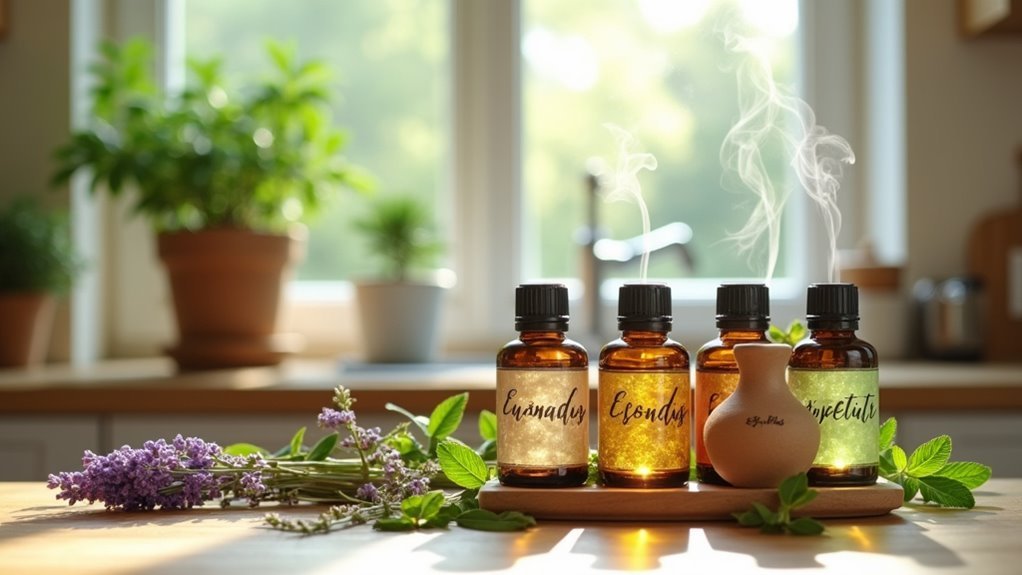

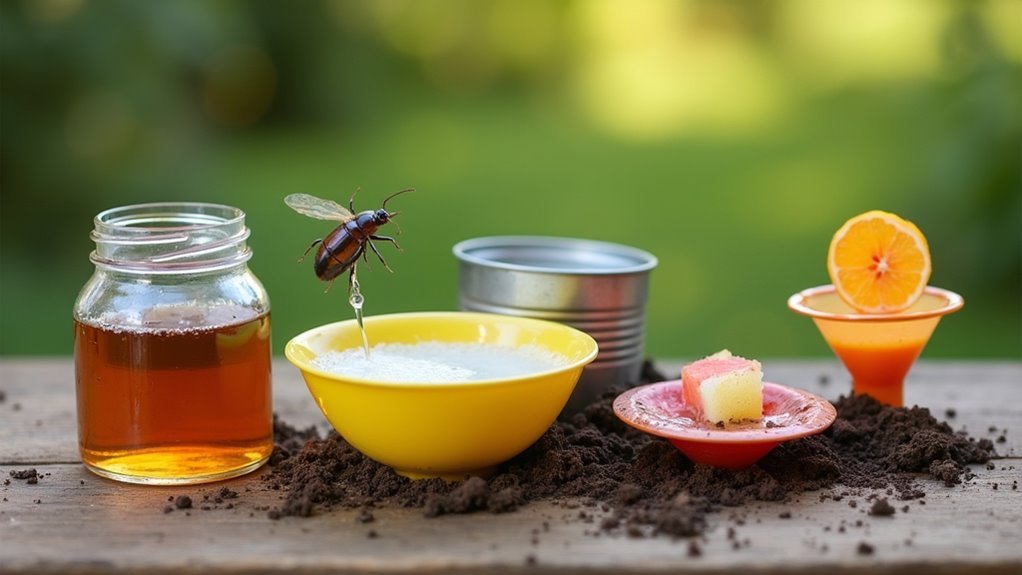

Leave a Reply